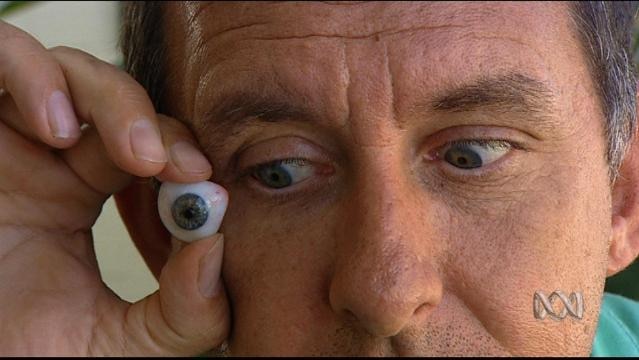Space to play or pause, M to mute, left and right arrows to seek, up and down arrows for volume.
SUBJECTS: Science
YEARS: 3–4, 5–6
To answer the question 'Are glass eyes really made of glass?' Peter Rowsthorn visits an ocularist who makes artificial eyes.
Join him as he investigates how these eyes are made.
Witness the skill of an ocularist, Jenny Geelen, as she creates an artificial eye to match Pete's existing eyes.
Things to think about
- 1.Why might a person need a glass eye? What other body parts can be replaced with artificial parts? What do you think about using glass as a material for making artificial eyes?
- 2.What does an ocularist do? Artificial eyes were made from glass. What global event caused a change in the materials used for artificial eyes? What are most artificial eyes made of today? Listen to the reasons why this material is well suited to this purpose.
- 3.What do ocularists need to know about eyes to create artificial eyes? Create a brochure for patients who need an artificial eye. Include the steps used to create an artificial eye. Show how an artificial eye replicates natural eye movement. You could include a frequently asked questions (FAQs) section, with simple, clear answers.
- 4.Research the properties and uses of acrylic plastic. List three properties that make acrylic an ideal material for making artificial eyes. What other things are made from acrylic? What properties of acrylic make it suitable for these uses? What are the disadvantages of acrylic? List three things that acrylic would not be a suitable material for.
Date of broadcast: 20 Jun 2008
Copyright
Metadata © Australian Broadcasting Corporation and Education Services Australia Ltd 2012 (except where otherwise indicated). Digital content © Australian Broadcasting Corporation (except where otherwise indicated). Video © Australian Broadcasting Corporation (except where otherwise indicated). All images copyright their respective owners. Text © Australian Broadcasting Corporation and Education Services Australia is licensed under a Creative Commons Attribution-ShareAlike 4.0 International License (CC BY-SA 4.0).
Posted